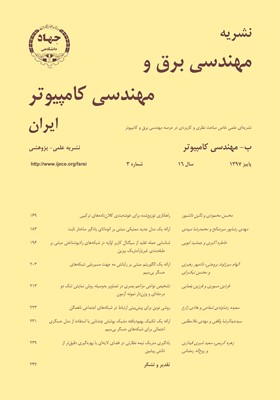شناسایی حمله تقلید از سیگنال کاربر اولیه در شبکههای رادیوشناختی مبتنی بر طبقهبندی غیر پارامتریک بیزین
محورهای موضوعی : مهندسی برق و کامپیوتر
1 - دانشگاه یزد
2 - دانشگاه یزد
کلید واژه: امنیتحمله تقلید از سیگنال کاربر اولیهخوشهبندی غیر پارامتریک بیزینشبکه رادیوشناختی,
چکیده مقاله :
رادیوشناختی به عنوان یک فناوری کلیدی برای مقابله با کمبود طیف فرکانسی در شبکههای بیسیم به طور گسترده مورد توجه قرار گرفته است. یکی از چالشهای مهم در تحقق شبکههای رادیوشناختی، امنیت این نوع شبکهها است. از مهمترین این تهدیدها، حمله تقلید از سیگنال کاربر اولیه است، بدین معنی که کاربر مخرب سعی دارد سیگنالی مشابه با سیگنال کاربر اولیه ارسال کند تا کاربران ثانویه را فریب داده و از ارسال سیگنالهای این کاربران در حفرههای طیفی جلوگیری کند و ضمن ایجاد ترافیک در شبکه، با به دست آوردن باند فرکانسی خالی، اطلاعات خود را ارسال کند. در این مقاله، روشی برای شناسایی حمله تقلید از سیگنال کاربر اولیه پیشنهاد میگردد که با خوشهبندی سیگنالهای ارسالی کاربران اولیه و کاربران مخرب، این سیگنالها را متمایز میکند. در این روش، تعداد سیگنالهای ارسالی در محدوده شبکه رادیوشناختی در طول خوشهبندی سیگنالها به دست میآید. با به کارگیری روش طبقهبندی مدل مخلوطی فرایند دیریشله که بر اساس روش غیر پارامتریک بیزین میباشد، سیگنالهای اولیه فعال در محیط طبقهبندی میشوند. همچنین برای دستیابی به سرعت همگرایی بالاتر در الگوریتم، روش فرایند رستوران چینی برای مقداردهی اولیه و نمونهبرداری غیر یکنواخت جهت انتخاب پارامتر خوشهها به الگوریتم اعمال میگردد.
Cognitive radio as a key technology is taken into consideration widely to cope with the shortage of spectrum in wireless networks. One of the major challenges to realization of CR networks is security. The most important of these threats is primary user emulation attack, thus malicious user attempts to send a signal same as primary user's signal to deceive secondary users and prevent them from sending signals in the spectrum holes. Meanwhile, causing traffic in CR network, malicious user obtains a frequency band to send their information. In this thesis, a method to identify primary user emulation attack is proposed. According to this method, primary users and malicious users are distinguished by clustering. In this method, the number of active users is recognized in the CR network by clustering. Indeed, by using Dirichlet process mixture model classification based on the Bayesian Nonparametric method, primary users are clustered. In addition, to achieve higher convergence rate, Chinese restaurant process method to initialize and non-uniform sampling is applied to select clusters parameter.
[1] B. Wang and K. J. R. Liu, "Advances in cognitive radio networks: a survey," IEEE J. of Selected Topics in Signal Processing, vol. 5, no. 1, pp. 5-23, Feb. 2011.
[2] X. Shengli, L. Yi, Z. Yan, and Y. Rong, "A parallel cooperative spectrum sensing in cognitive radio networks," IEEE Trans. on Vehicular Technology, vol. 59, no. 8, pp. 4079-4092, Oct. 2010.
[3] R. Saifan, A. E. Kamal, and Y. Guan, "Efficient spectrum searching and monitoring in cognitive radio network," in Proc. IEEE 8th Int. Conf. on Mobile Adhoc and Sensor Systems, MASS’11, pp. 520-529, Valencia, Spain, 17-22 Oct. 2011.
[4] R. W. Thomas, R. S. Komali, B. J. Borghetti, and P. Mahonen, "A Bayesian game analysis of emulation attacks in dynamic spectrum access networks," in Proc IEEE Symp. on New Frontiers in Dynamic Spectrum, 11 pp., Singapore, Singapore, 6-9 Apr. 2010.
[5] C. Zhao, L. Xie, X. Jiang, L. Huang, and Y. Yao, "A PHY-layer authentication approach for transmitter identification in cognitive radio networks," in Proc. Int. Conf. on Communications and Mobile Computing, CMC’10, vol. 2, pp. 154-158, Shenzhen, China, 12-14 Apr. 2010.
[6] Z. Caidan, W. Wumei, H. Lianfen, and Y. Yan, "Anti-PUE attack base on the transmitter fingerprint identification in cognitive radio," in Proc. Int. Conf. on Wireless Communications, Networking and Mobile Computing, 5 pp., Beijing, China, 24-26 Sept. 2009.
[7] W. L. Chin, et al., "Channel-based detection of primary user emulation attacks in cognitive radios," in Proc. IEEE Vehicular Technology Conf. (VTC Spring), 5 pp, Yokohama, Japan, 6-9 May 2012.
[8] H. Li and Z. Han, "Dogfight in spectrum: combating primary user emulation attacks in cognitive radio systems, part i: known channel statistics," IEEE Trans. on Wireless Communications, vol. 9, no. 11, pp. 3566-3577, Nov. 2010.
[9] N. Nguyen-Thanh, P. Ciblat, A. Pham, and V. Nguyen, "Surveillance strategies against primary user emulation attack in cognitive radio networks," IEEE Trans. on Wireless Communications, vol. 14, no. 9, pp. 4981-4993, Sep. 2015.
[10] C. Biao, K. M. Borle, and D. Wenliang, "A physical layer authentication scheme for countering primary user emulation attack," in Proc. Int. Conf. on Acoustics, Speech, and Signal Processing, ICASSP'13, pp. 2935-2939, Vancouver, BC, Canada, 26-31 May 2013.
[11] X. Chunsheng and M. Song, "Detection of PUE attacks in cognitive radio networks based on signal activity pattern," IEEE Trans. on Mobile Computing, vol. 13, no. 5, pp. 1022-1034, May 2014.
[12] N. T. Nguyen, R. Zheng, and Z. Han, "On identifying primary user emulation attacks in cognitive radio systems using nonparametric Bayesian classification," IEEE Trans. on Signal Processing, vol. 60, no. 3, pp. 1432-1445, Mar. 2012.
[13] Y. W. Teh, Dirichlet Processes, Encyclopedia of Machine Learning, Springer, 2010.
[14] M. Bkassiny, S. K. Jayaweera, and L. Yang, "Multidimensional Dirichlet process-based non-parametric signal classification for autonomous self-learning cognitive radios," IEEE Trans. on Wireless Communications, vol. 12, no. 11, pp. 5413-5423, Nov. 2013.
[15] M. D. Escobar and M. West, "Bayesian density estimation and inference using mixtures," J. of the American Statistical Association, vol. 90, no. 430, pp. 577-588, Jun. 1995.
[16] K. P. Murphy, Machine Learning: A Probabilistic Perspective, MIT Press, 2012.
[17] J. R. Hershey and P. A. Olsen, "Approximating the Kullback Leibler divergence between Gaussian mixture models," in Proc. IEEE Int. Conf. on Acoustics, Speech and Signal Processing, ICASSP'07, vol. 4, pp. 317-320, Honolulu, HI, USA, 15-20, Apr. 2007.


